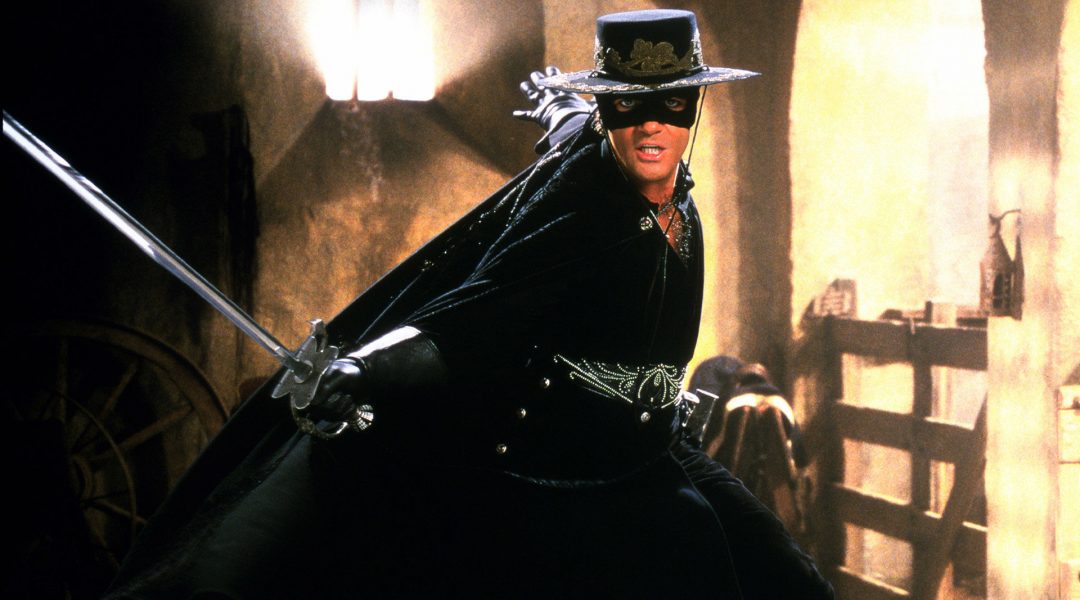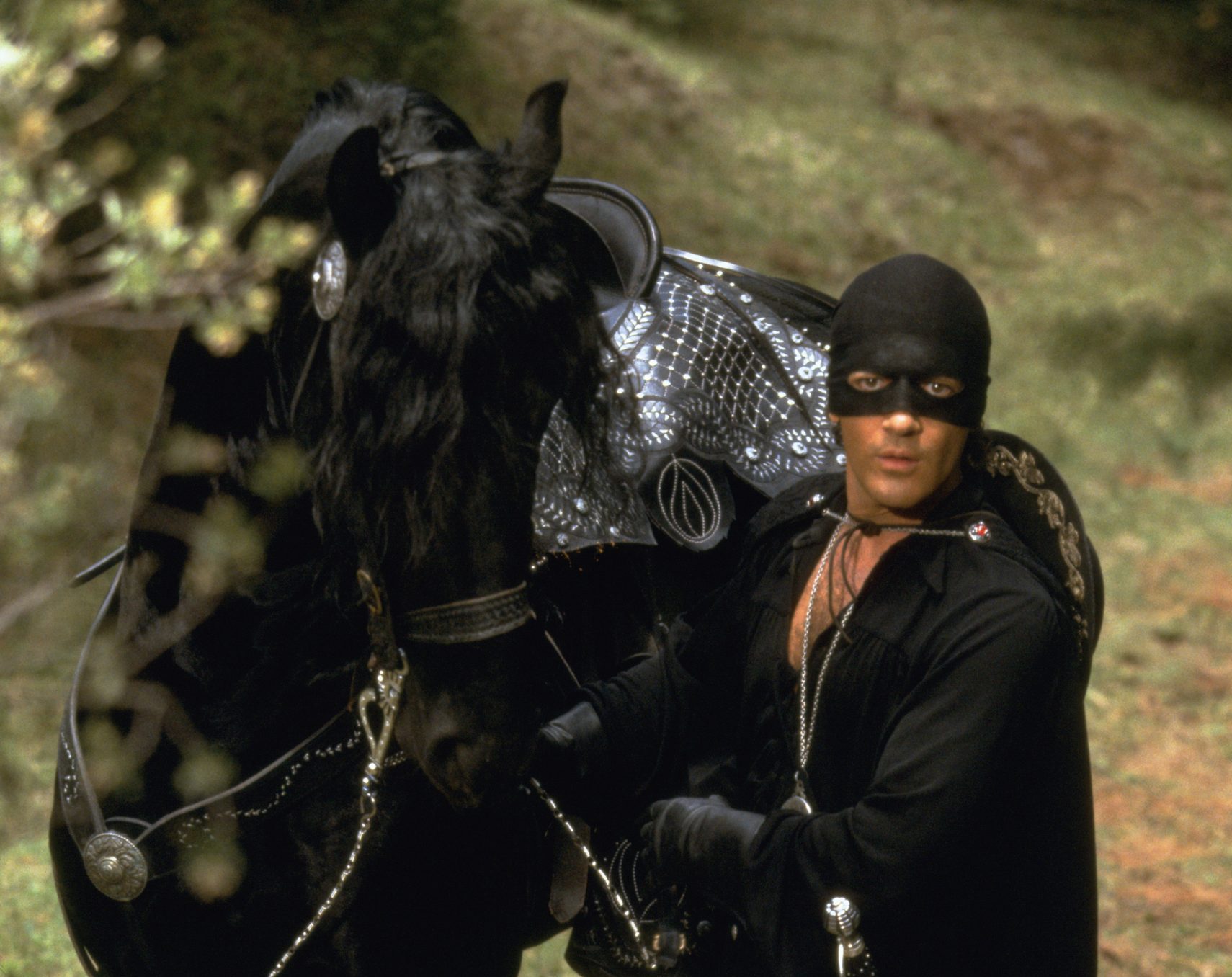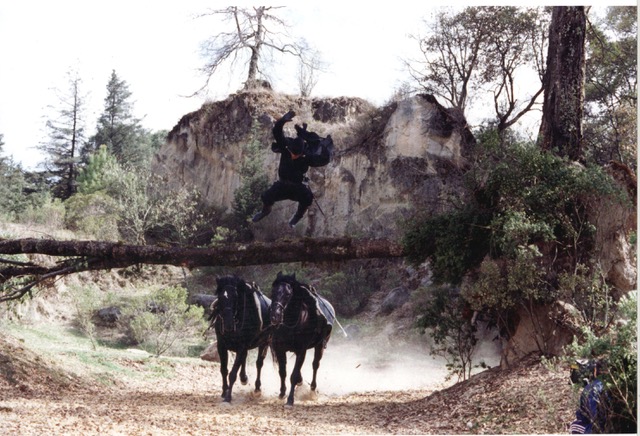The Mask of Zorro At 25

It’s been 25 years since “retiring” as Zorro that Don Diego de la Vega (played by Anthony Hopkins) groomed his successor, Alejandro Murieta (Antonio Banderas), to fill his stirrups as the legendary righter-of-wrongs in The Mask of Zorro, released by TriStar Pictures/Amblin Entertainment in 1998.
Who can forget the chase scene in The Mask of Zorro when Antonio Banderas leap-frogs horse to horse, knocking off soldiers from behind, finally and dramatically Roman riding as he straddles two charging steeds and vaults over a (real) tree branch as they race beneath. Then, he lands atop them standing, still at breakneck speed. Among the best-ever Western chase scenes, the sequence relied on someone other than Banderas, who wasn’t the man beneath the mask. That was Tad Griffith, an elite third-generation trick rider, making his remarkable Hollywood debut.
“It changed my life. It was a tremendous calling card for me,” says Griffith, who moved to Los Angeles after Zorro, wrapping an 8,000-performance run in Las Vegas at The Excalibur. “I was just on the unit for that sequence,” adds Griffith, who brought his own horses for Zorro. “The only reason that was possible at the level it happened is because I had the perfect horses. They were extremely experienced and proficient partners. They made the sequence possible. I actually did an iron cross. I was suspending myself between two running horses. I’d get into that position and drop down and hold it.”
“That stunt either worked or it didn’t,” he says. “The horses had to be brought in at the perfect stride. Three strides from the tree, I had to throw the reins down and jump in kind of a semicircle to where they were going to be. This was real. [No CGI.] You ride your horses at a tree. If they weren’t exactly on the correct lead three strides out, I couldn’t even jump off. It was too close. I had to jump four feet to get over the tree to leave enough room for their withers not to hit the bottom of the tree,” says Griffith, who soon after conquering the stunt founded A Tad Western Production Company.
Second unit action director Glenn Randall Jr. was winding up his storied 40-year career (Raiders of the Lost Ark) on Zorro. “Zorro changed a lot of people’s lives,” says Randall, whose father, Glenn Randall Sr., trained Roy Rogers’ Trigger. “Another young man, Casey O’Neill, also doubled Antonio and played Zorro. Both of those kids had not really had a career in the film business until I hired them on Zorro. Tad’s dad was a world champion trick rider and bull rider. I realized who his dad was,” Randall says.
 THE MASK OF ZORRO © 1998 Global Entertainment Productions GmbH & Co. KG. All Rights Reserved. Courtesy of Columbia Pictures
THE MASK OF ZORRO © 1998 Global Entertainment Productions GmbH & Co. KG. All Rights Reserved. Courtesy of Columbia Pictures
O’Neill, who’d worked in Las Vegas with Griffith at The Excalibur’s Tournament of Kings dinner show, vividly remembers first meeting Randall. “At that time, I was sending out VHS tapes with my headshot to try to get into the business. I was hoping to go for an interview, get a couple days, a week on the show. When we did [Zorro], Glenn said, ‘I have stacks of all these tapes. I rarely even look at them. Somehow, yours was at top. That’s why you’re here.’”
Tryouts took place at the Randall Ranch in Newhall, California, O’Neill recounts every detail. “Glenn said, ‘Do you do bullwhips?’ I just did a few bits and pieces, and I remember him saying, ‘That’s enough.’ Then, he says, ‘Do you do sword work?’ I’d just been training and practicing almost a year.” Stopped short after demonstrating a couple of maneuvers, O’Neill worried things weren’t going well. “Tad had his horses there. I got on and did one lap around the arena — double vaults — a very easy trick, like the first thing you learn.” Before a second lap, he got word, You can get off. “I was deflated!” O’Neill says. “Then, Glenn said, ‘Hey, kid, come see me before you leave.’ I thought maybe he’s going to give me a pep talk.” Instead, O’Neill heard, “‘You can leave here knowing you got the job doubling Antonio.’ I was completely blown away!”
O’Neill worked the entire production doubling Banderas (among others) on such heart-pounding scenes as Zorro crashing through the (balsa wood) wall of the soldier barracks on his horse Tornado and galloping up the stairs of a real building to rear a massive Friesian horse named Freddie on top. “It was a tiny little platform on the top of that building … my God! … 30 feet to the ground. We ran up and down the actual stairs,” O’Neill says. “We did it practically! [Practical effects are created by physical means as opposed to CGI.] On that show, I did so much stuff I never dreamed about doing. There are so many things we did practically on that movie that you would never do these days.
After the movie, O’Neill’s Hollywood career skyrocketed to second unit coordinating and directing. “Zorro was definitely my big stepping stone in the business, and I never looked back,” he says. “I did The Lord of the Rings for two and a half years. I coordinated all the big battles — the Wizard riding without a bridle.” He also counts blockbuster Top Gun Maverick among recent credits along with the upcoming Twisters.
O’Neill, who grew up at his parents Lake Arrowhead Equestrian Center in California’s San Bernardino Mountains, says his father's rare connection to horses got him his start in the movies and still resonates with him today. “Horses is what got me into the business and my background in them,” O’Neill says. “I started taking other jobs so much that people now don’t even realize that’s my background, what got me into the business. My career has changed a lot since those days.”
Randall left Hollywood, retiring in South Carolina soon after The Mask of Zorro, a timeless grand finale for his stellar career. “It was a long grueling shoot. They pretty much let me direct the whole second unit sequence. I designed it, storyboarded it, they approved it, and I went out and shot it,” he says. What stands out a quarter-century later? “I remember they couldn’t find locations. I found where I wanted to shoot the chase sequence. The whole company came out to look at it — the director [Martin Campbell] and producers — and it rained. Got the bus stuck. It was a hell of a mess, but the director used the location.” Randall found the dramatic “gold mine” location, too, when he got lost once and accidentally bumped into the area. Four months of construction, three tons of nails, and 85 tons of lumber later, and the gold mine was ready for action.
Flashing back on Zorro’s star, “Banderas was a kick to work with,” Randall says. “He had lots of enthusiasm. I designed a barrel, we mounted it on a camera truck, put a saddle on it, and he mimicked some of the moves Tad and Casey did. He was game for anything.”
 Image courtesy of Tad Griffith
Image courtesy of Tad Griffith
Zorro’s dialect coach, Joy Ellison — whose own Hollywood career as a child actor includes a role as Opie’s girlfriend on The Andy Griffith Show — worked with Banderas before coming to Zorro through him. It was her first gig together with Catherine Zeta-Jones (Elena), which in turn led to Chicago and other films. “I was in on her actual casting, which happens very rarely. It was just [director] Martin and myself. A French girl, who was Martin’s choice in the beginning, was upset she was not reading with Antonio. Then we saw Catherine. We were in a big, kind of empty room. Something was wrong with the doors. When Catherine came and pushed those two doors, they both flew open and smashed against the wall! She charged in with all this energy, eyes sparking, and a big smile. That entrance did it all. She was beautiful, dynamic, had this great voice, and moved like a cat. It was her big break here in the States.” Zeta-Jones’ role as Elena launched her stardom.
A week after landing the role, Zeta-Jones was taking riding lessons. Glenn Randall’s legendary brother Corky Randall (The Black Stallion), who returned from semiretirement to become Zorro’s livestock coordinator, gave his wrangler son Bruce (Randall) the job of training her.
“I’d ridden a horse sidesaddle in many things for period costume dramas that I did in England. Basically, they’d put me on the horse, arrange my dress, and I got off as quickly as possible,” said Zeta-Jones while filming Zorro in Mexico. “I was completely honest. I said, ‘I’m not very good on horses.’ Bruce trained me. Within a week, I was galloping. I couldn’t believe it. I had to look like a good horsewoman. It was American riding, Western, which I thought was much easier, more relaxed.
As for experiencing horses on set, Zeta-Jones remarked, “Horses have a mind of their own. If they don’t want to play, they just don’t play — unlike us actors. It’s like working with children in a way.” She was reminded of a tender scene together with Anthony Hopkins grooming the black Friesian horse in the stable. “The horse was kind of hiding Tony’s face all the time. It was like, ‘Get out of my close-up.’”
She made the effort to acquire skills for her role. “When I was not working, I’d go to the set. You have to hang around a lot, and I’d have my hair in big curlers with a big scarf and half made-up. I’d have my riding [lessons] with my curlers in. Me and Bruce would go off just behind the set, where there were nice fields or a nice landscape, and we’d go riding with my rollers in. I got more confidence. I have enough to do when I’m acting. I don’t want to be thinking or worried about which way the horse is going to go. You’d have marks you’d have to stop. Sometimes you’d have to ride, gallop around, and then bring him to a stop at this particular mark. Riding, stopping, making him go again. I’ve danced all my life. I’m a dancer by trade. I was using different muscles, but then I got the rhythm of the horse.”
Riding was only part of all Zeta-Jones described. “It was like boot camp — but they fed you and didn’t shave your head! Every day it was like sword fencing for two hours, horse riding for an hour, dancing for two hours, voice coaching, Spanish accent, and you’d go to sleep and just get up in the morning, dancing, riding, this whole thing in training. But we all knew our routines, and we were all confident on a horse.”

Không có nhận xét nào:
Đăng nhận xét